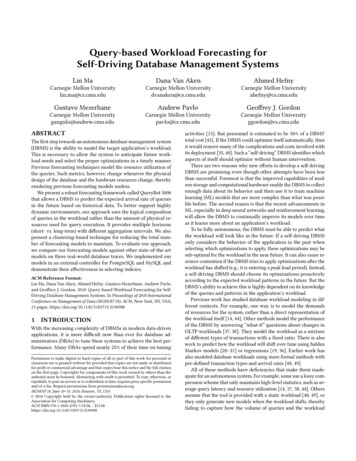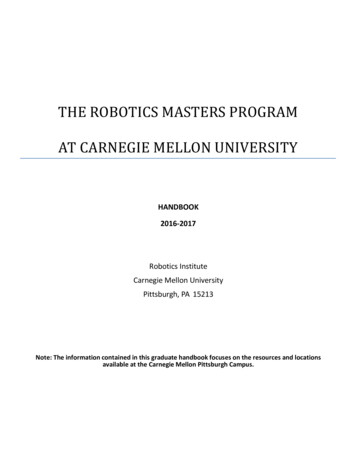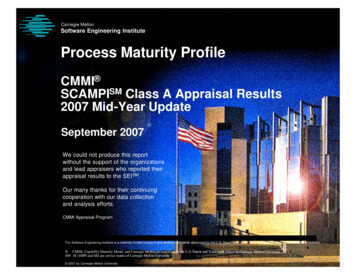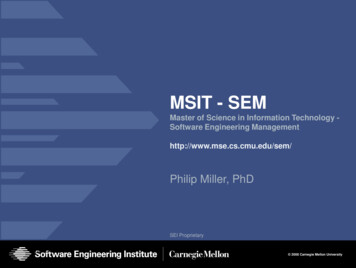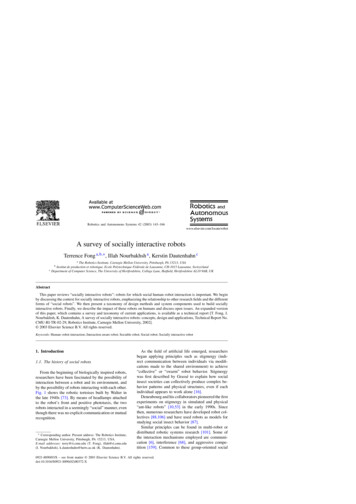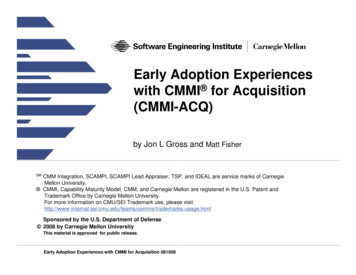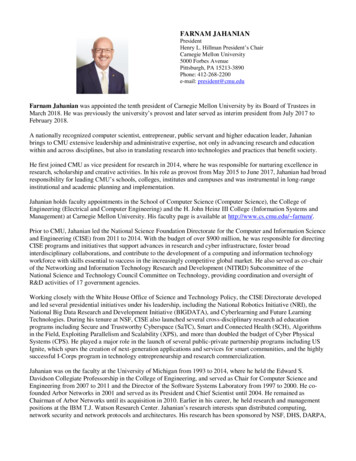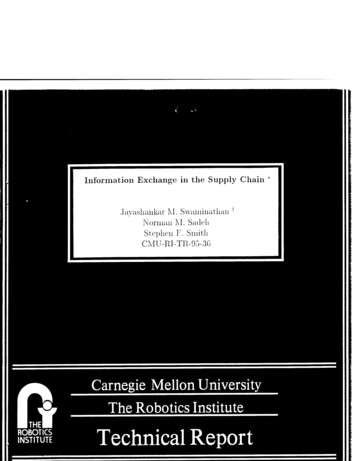
Transcription
Information Exchange in the Supply Chain *.Jayasliankar M. SwamiiiatlianNorman M. SadehSto])lion F. SmithCMU-RI-TR-95-3G TCarnegie Mellon UniversityThe Robotics InstituteTHEI ROINSSSStTechnical Report
DISCLAIHEl NOTICETHISDOCUMENTISBESTQUALITY AVAILABLE. THE COPYFURNISHED TO DTIC CONTAINEDA SIGNIFICANT NUMBERPAGESWHICHREPRODUCEDOLEGIBLY.OFNOT
Form ApprovedOMB No. 0704-0188REPORT DOCUMENTATION PAGE.- -.»,, .«-« ,., , ,.,,. ,. «imat»atoa eraci'W"'"'ir pe.w-esporse, including the time tor reviewing instructions, searching existing data «sure«.Put*« reporting Burden for"'y «* * '"* J "0" ' „q ?hrc* :«,onV« m mat.on Send comments regarding th,s burden estimate or any other aspect of thisgathering and maintaining the data needed.,»nd « "9 a *" ?'", ,„„,(,„ Heaoouarters Services Directorate for information Ooerat.ons and Reoorts. 1215 Jefferson1. AGENCY USE ONLY (leave blank)2. REPORT DATEOctober 19953. REPORT TYPE AND DATES COVEREDtechnical5. FUNDING NUMBERS4. TITLE AND SUBTITLEInformation Exchange in the Supply Chain6. AUTHOR(S)Jayashankar M. Swaminathan, Norman M. Sadeh, Stephen F. Smith8. PERFORMING ORGANIZATIONREPORT NUMBER7. PERFORMING ORGANIZATION NAME(S) AND ADDRESS(ES)The Robotics InstituteCarnegie Mellon UniversityPittsburgh, PA 15213CMU-RI-TR-95-3610. SPONSORING/MONITORINGAGENCY REPORT NUMBER9. SPONSORING/MONITORING AGENCY NAME(S) AND ADDRESS(ES)Advanced Research Projects Agency11. SUPPLEMENTARY NOTES12b. DISTRIBUTION CODE12a. DISTRIBUTION AVAILABILITY STATEMENTApproved for public release;Distribution unlimited13. ABSTRACT [Maximum200woras)In recent years, manufacturers have taken initiatives to integrate information within their supply chains in order toprovide quick response to customer needs. In this paper, we study the influence of sharing supplier capacity information(such as availiable-to-promise (ATP)) on the performance of a supply chain. We consider a supply chain in which amanufacturer orders raw materials from two alternative suppliers differing in cost and capacity. We first derive theoptimal inventory policy for the manufacturer under stochastic demand. Subsequently, using simulation, we comparedifferent information sharing scenarios. Among other results our study shows that, while information sharing isbeneficial to overall supply chain performance, in can be detrimental to individual entities in the supply chain. We findthat when supplier adoption costs of the information system are negligible, the more expensive supplier makes lessprofits under information sharing. However, it is forced to share information. When adoption costs are substantial, ourresults indicate that it is better for the manufacturer to have information links with fewer suppliers (a subset of potentialsuppliers).15. NUMBER OF PAGES14. SUBJECT TERMSsupply chain, stochastic demand, supply uncertainty, available-to-promise (ATP)information, inter-organizational system (IOS) adoption17. SECURITY CLASSIFICATIONOF REPORTunlimited\I .N 7"ülV.V - f\.18. SECURITY CLASSIFICATIONOF THIS PAGEunlimited19. SECURITY CLASSIFICATIONOF ABSTRACTunlimited34 PP16. PRICE CODE20. LIMITATION OF ABSTRACT !unlimited"'aroarc -nrrr, ;93 : r
rInformation Exchange in the Supply ChainJayashankar M. Swaminathan *Norman M. SadehStephen F. SmithCMU-RI-TR-95-36The Robotics InstituteCarnegie Mellon UniversityPittsburgh, PA 15213-3891October 199519960724 105*This research was supported by Advanced Research Projects Agency under contracts #F3060291-F-0016 and #F30602-90- C-0119 and, William Larimer Mellon Fellowship* Graduate School of Industrial Administration and The Robotics Institute, Carnegie Mellon University, Pittsburgh, PA-15213.
AbstractIn recent years, manufacturers have taken initiatives to integrate informationwithin their supply chains in order to provide quick response to customer needs.In this paper, we study the influence of sharing supplier capacity information(such as available-to-promise (ATP)) on the performance of a supply chain. Weconsider a supply chain in which a manufacturer orders raw materials from twoalternative suppliers differing in cost and capacity. We first derive the optimalinventory policy for the manufacturer under stochastic demand. Subsequently,using simulation, we compare different information sharing scenarios. Amongother results our study shows that, while information sharing is beneficial tooverall supply chain performance, it can be detrimental to individual entities inthe supply chain. We find that when supplier adoption costs of the informationsystem are negligible, the more expensive supplier makes less profits under information sharing. However, it is forced to share information. When adoptioncosts are substantial, our results indicate that it is better for the manufacturerto have information links with fewer suppliers (a subset of potential suppliers).Key words: Supply chain; stochastic demand; supply uncertainty; available-topromise(ATP) information; inter-organizational system(IOS) adoption.
1IntroductionIn a highly competitive market, manufacturers face the challenge of reducing productdevelopment time, improving quality, and, reducing cost and leadtime for production.Their success in overcoming these challenges depends to a great extent on their abilityto integrate individual plants (entities) into a tightly coupled supply chain.Man-agement of material flow across several sites of the same enterprise is in itself quitechallenging. This challenge is further complicated due to diverse (sometimes conflicting) interests of different entities in the supply chain.Recent studies [Helper andSako(1995), Udo(1993), ECR(1993)] indicate that many manufacturers are sharing information (through inter-organizational information systems) with their suppliers toimprove performance of the supply chain in terms of cost and customer service. Forexample, JC Penny installed a large-scale computerized inventory system to automatically reorder products from 281 suppliers, which accounted for more than 50 % oftheir business [Mayo(1986)]. However, the extent of benefits due to information sharing to different organizational entities is not well quantified. [Srinivasan et.al(1994),Cole and Yamakushiji(1984)] show in their empirical study that sharing informationwith the suppliers led to a significant improvement in the performance of Chryslerand Toyota respectively. However, [Cash and Konsynski (1985)] indicate that interorganizational systems (IOS) in many cases, under the guise of faster information flowshifted inventory holding costs and business risks to suppliers.In this paper, we study the influence of sharing supplier information on differentorganizational entities in the supply chain. We consider a manufacturer who procurescomponents from two alternative suppliers while facing stochastic demand for a singleproduct. Suppliers differ in terms of cost and available-to-promise (ATP) capacity.The more expensive supplier shows less variation in the capacity allocation as compared to the other supplier. We consider a discrete time single period problem wheresequence of events is as follows- (1) Suppliers calculate the ATP quantity and assemblecomponents to satisfy the ATP demand. (2) Manufacturer places an order with one ormore suppliers. In case, ATP information is shared then it uses that information whileordering, otherwise, it uses an approximation based on historical data. (3) Suppliersdeliver the order in full or part based on the order size. They incur a holding costfor left over inventory and stock-out cost for unsatisfied demand (no backlogging). (4)
Manufacturer converts raw inventory received from suppliers into finished products.(5) Demand occurs at the end of the period. Manufacturer uses finished products tosatisfy demand. Holding cost is incurred on excess inventory (carried to next period)and stock-out cost for unsatisfied demand (no backlogging). We derive the optimal inventory policy that minimizes expected cost incurred by the manufacturer under aboveconditions. We also provide a newsboy interpretation to the policy and generalize itto multiple suppliers.In our computational study (with two suppliers), we simulate the inventory policyfor a large number of periods under different demand scenarios and capacity allocationsby suppliers. We compare performance in terms of costs incurred by the manufacturer,profits of suppliers and percentage of demand satisfied for alternative models of information sharing (of supplier ATP capacity)- (1) information links with both suppliers,(2) information link with one supplier and (3) information links with no supplier. Ourresults indicate that the supply chain performs better in terms of cost and quality of services (measured in terms of percentage of demand satisfied on time) under informationsharing. We find that information sharing improves performance of the manufacturerand the less expensive supplier. We also find that the more expensive supplier is forcedto share information though information sharing is not of inherent advantage to it.Subsequently, we analyze the impact of introduction of supplier adoption costs (costto set-up and maintain information links). [Klein(1992) and Kelleher(1986)] indicatethat manufacturers, in practice, pay a subsidy (increase in price paid per component)to suppliers in order to compensate them for incurring additional investment for information sharing. Also, amount of subsidy (increase in price) is directly related to costincurred by suppliers to adopt the information system. In our computational study,we vary the amount of subsidy given by the manufacturer in alternative models ofinformation sharing. Our results indicate that if cost of adoption of the informationsystem is relatively large (higher subsidy) then it is better for the manufacturer notto have information links with any of the suppliers. However, under lower adoptioncosts it is better for the manufacturer to set-up information links with one or both thesuppliers. Further our results indicate that the manufacturer is more likely to maintaininformation links with suppliers when there is greater uncertainty in the supply process.Literature related to supply chain analysis have indicated that dynamics associ-
ated with a supply chain can be extremely complex [Lee and Billington (1992)] and inmost cases, can be empirically verified only through simulation. [Cohen and Lee(1988)]present a comprehensive approximation of a supply chain model that incorporates rawmaterials, production and a distribution system and provide valuable insight into dynamics of supply chains where demands are stochastic and all locations use reorderingpolicies specified by two numbers (i.e. (s,S) or (Q,R)). [Pyke and Cohen (1993),(1994)]study a three stage linear integrated production-distribution system, develop the distribution for key random variables, and discuss managerial insights that arise from theanalysis. In this paper, we use simulation to study the influence of information sharingon the supply chain. Comparative analysis of diversification strategies for the manufacturer under supply uncertainty are discussed in [Moinzadeh and Nahmias(1988),Ramasesh et.al (1991)(1993), Lau and Lau(1994)]. [Anupindi and Akella(1993)] studya model where a manufacturer facing uncertain demand procures a component from twoalternative suppliers. One of the suppliers is more expensive than the other in termsof cost but is more reliable in terms of delivery. The authors derive optimal inventory policy for the manufacturer under different scenarios (corresponding to shipmentsfrom suppliers) for single and multiple period problems. Our model is related to theabove model, however, we additionally include capacity restrictions on suppliers andanalyze the influence of information sharing in such a situation. Inter-organizationalinformation systems have been studied predominantly using economic models [Riggins et al.(1994), Marcus(1990), Oren and Smith(1981)]. These models consider utilityfunction of the user to join the information network. [Wang and Seidmann(1995)] usean economic model to study the influence of electronic data interchange (EDI) and itsadoption by suppliers. They consider a downward sloping deterministic demand forthe manufacturer. They find that it is optimal for the manufacturer to adopt EDI withfewer suppliers when the supplier adoption costs are high. Interestingly, in this paperwe find a similar result in the computational study. In our problem, the manufacturerfaces stochastic demand, shares ATP information and, optimizes ordering, stock-outand inventory costs.The rest of the paper is organized as follows. In section 2, we describe the conceptualmodel and our hypotheses. Subsequently, we develop the basic analytical model. Wederive the optimal inventory policy and generalize it to multiple suppliers. In section 3,we describe alternative models of information sharing and supplier adoption costs. In
section 4, we discuss our computational results. In section 5, we present our concludingremarks and identify opportunities for future research.2Basic ModelIn this section, we first introduce the conceptual model. Subsequently we formulate abasic analytical model. We derive the optimal inventory policy for the manufacturer.We also provide a newsboy interpretation to the policy and generalize our results tomultiple suppliers.2.1Conceptual ModelRecent studies have shown that quick propagation of relevant information can enhancethe performance of a supply chain to a great extent [Udo(1993)j. Information transferin one form or the other occurs between every pair of interacting entities in a supplychain, differing only in the type and time of sharing of information. In this study, weconsider a manufacturer who orders goods from two alternate suppliers. The information that is being shared is the ATP capacity of suppliers for this manufacturer. Themanufacturer orders goods from suppliers in each period after incorporating supplierinformation in the reordering policy.Information sharing can have beneficial or detrimental effect on an entity dependingon the type of information shared and with whom it is shared. We have identified threebasic hypotheses with respect to exchange of supplier information which are as follows. HI: Supplier information sharing leads to better performance in the supply chainboth in terms of cost and quality of service.Empirical evidence has indicated that sharing information on demand forecastsand delivery of shipments has significantly improved the performance of the supply chain at Chrysler [Srinivasan et.al (1994)] and Toyota [Cole and Yamakushiji(1984)]. We feel that supplier information should also have a similar effect because it reduces the amount of uncertainty in the system. H2: Supplier information sharing is beneficial to all the organizational entitiesin the supply chain.In our model, we incorporate supplier information in the reordering decision
process of the manufacturer. Information sharing reduces the uncertainty in thesupply process, and as a result, we feel that it would be beneficial to all entities,though the degree of benefit may vary. However, [Cash and Konsynski (1985)] citeexamples where information sharing shifted inventory holding costs and businessrisks to the supplier. H3: Suppliers would be willing to share information.This hypothesis is based on the empirical evidence which shows that there is asignificant increase in the number of suppliers who shared information with themanufacturer in the last decade [Helper(1991), Helper and Sako(1995)].In order to evaluate these hypotheses, we first develop a basic model for manufacturer/supplier interaction in a simple two-tiered supply chain, and establish an optimalordering policy for the manufacturer. We then use the basic model to define a seriesof more specialized models, each making different assumptions about the extent andcost of supplier information exchange. Through simulation we evaluate each of thesemodels and relate results obtained to hypotheses identified above.2.2Analytical ModelIn the basic model, we consider a supply chain in which there is a single manufacturerwho orders goods from two suppliers. Suppliers differ in cost and the capacity allocatedfor the manufacturer. We assume that suppliers can procure raw material immediatelyand supply them in the same period. However, they have a limited capacity which determines the ATP quantity. This quantity is perceived as a stochastic allocation by themanufacturer because it changes from period to period. The fluctuations in capacityallocations occur because suppliers face demand from other manufacturers as well. Wedo not address the issue as to how capacity allocation is done at the supplier's end. Inorder to keep the analysis tractable we assume that for a particular manufacturer theallocation in each period is a random variable from a stationary distribution. The distribution corresponding to the less expensive supplier has more variance for the samemean value.To formulate the model more precisely, we use the following notations: : random demand for the manufacturer in a period.
Cf. available-to-promise capacity of supplier i in a period.Pii cost of procuring the component from supplier i.x: on-hand inventory for the manufacturer at the start of a period.Wi\ quantity ordered from supplier i in a period.ßi(wi): 0-1 variable indicating whether the whole quantity u\- would be receivedfrom supplier i. ßi{wi) 1 indicates that wt would be received completely.Mm)-l - ßiW7,-: quantity that is expected from supplier i when ßi(wi) 0.7r: per unit per period stock-out cost for the manufacturer.h: per unit per period holding cost for the manufacturer.fii'. mean of C;.er,-: standard deviation of C{./( ): probability density of .F( ): cumulative density of .M(x, w1,w2): expected cost incurred by the manufacturer in a single period whenthe on-hand inventory is x and iol5 w2 quantities are ordered from the suppliers.We consider a single period model where the manufacturer minimizes expected costincurred M(x,w1,w2). M(x,wx,w2) consists of- (1) cost of procuring the componentfrom suppliers, (2) cost of carrying excess inventory or holding cost at the rate of hper item and (3) cost of falling short of the demand or the stock out cost at the rateof 7T per item. In any given period, the following sequence of events takes place: Suppliers calculate the ATP quantity d and assemble components to satisfy theATP demand. Manufacturer places an order with one or more suppliers based on the currentinventory level x and supplier capacity information. When ATP information isavailable the maximum amount that could be expected (7,-) is d i,e 7; C,-.
Suppliers deliver the order in full or part based on the order size. They incur aholding cost for left over inventory and stock-out cost for unsatisfied demand (nobacklogging). Manufacturer pays for goods received and converts them into finished products. Demand occurs at the end of the period. Manufacturer uses the finished inventory to satisfy demand. Holding cost is incurred on excess inventory (carried tothe next period) and stock-out cost for unsatisfied demand (no backlogging).2.2.1Single Period Cost Function for the ManufacturerThe expected cost incurred by the manufacturer is given by the equation below.M(X,WUW2) PlWiß Wi) p2W2ß2(w2) Plllßlim) P2l2ß2(W2)ooy ir. j (w1,w2,y).J(ti-y)f(Odtyy Ä.JXu .yJ./fo-O/tfKwhere,ßx{w1).ß2{w2)#I(U I)-AJ(U 2) f ?/ z Wi 72y wi w22/ z 7i 72y x f1 w2otherwiseThe function f (wi,w2,y) indicates the probability that on-hand inventory with themanufacturer is y after orders have been received (the on-hand inventory before ordering was x) given that it ordered toi and w2 items from suppliers. For example, if theon-hand inventory with the manufacturer after orders arrive is x w1 w2j then bothsuppliers supplied the whole quantity. Thus, the value of j is given by ßi{wi).ß2{w2),which is the probability that both suppliers supply the whole quantity W{.The cost of ordering to,- items from each of the supplier is either pi.Wi, in case themanufacturer expects to receive the whole quantity (to,-) or pi.ji, when the manufacturer expects that the supplier would supply only 7;. The expected cost of holding
inventory given that y is the on-hand inventory after orders have been received is givenyby /j. J(y )f( )d where the integral term represents expected number of leftoveritems after the demand is satisfied. The total expected inventory holding cost isobtained by multiplying the above cost by the probability of realizing the value y givenby (f (wi,w2,y) and summing over all possible values of y. Similarly, expected cost ofstock-out given that y is the on-hand inventory after orders have been received is givenby 7T. /( - y)f(Odt where the integral term represents expected number of items thatywere stocked out. The total expected cost of stock out is obtained by multiplying theabove cost by the probability of realizing the value y given by f (wi,w2, y) and summingover all possible value of y. Recall that /?; is a 0-1 variable as a result only four valuesof y are feasible.Proposition 2.1 : The single period expected cost function is convex.Proof: Refer Appendix-I.2.2.2Inventory Policy for the ManufacturerIn this section we derive the optimal inventory policy for the manufacturer.Proposition 2.2 : If the single period expected cost function M(x,wuw2) is convex then there exist numbers w a,w a,wlb,a and b such that the optimal procurementpolicy has the structure as follows :-(w{,w*2) ' (WU,W2a)*/X b(u Jo,0)(0,0)ififa x -x aProof: Refer Appendix-I for the proof of the existence of a solution and the values ofwia w2aiwu aand b. These values are as follows.w*la min( F-1{7 - )-x)
u ,2a min(i2,F a(—-T-)-Z-7I)7T ftThe policy indicates that there are three distinct regions in which the inventorycould fall, based on which, the manufacturer decides to place orders with suppliers.In case the manufacturer has enough on-hand inventory (a; a), it does not place anorder. If the on-hand inventory is more than b but less than a then orders are placedwith the less expensive supplier and orders are placed with both suppliers if on-handinventory is less than b.The structure of our policy is similar to the policy obtainedby [Anupindi and Akella(1993)]. However, they consider infinite capacity and constantreliability factor # (not dependent on the order quantity) for each of the suppliers. Asa result, the boundary values (a and b) as well as the order quantities are different inthe two models.The inventory policy indicates that an increase in variance of demand leads to anhigher value for both a and b (refer Figure 1). However, the increase in a is greaterthan that of b because pi p2. As a result, the difference between a and b increases.Recall that this difference is the region where components are ordered only from theless expensive supplier.Thus, increase in the variance of demand leads to higherbusiness volume for the less expensive supplier. It should be noted that the regionwhere components are ordered from both suppliers also increases (due to increasein b). Thus, an increase in variance of demand leads to larger orders for suppliers.An intuitive explanation for the above is that increase in variance of demand forcesthe manufacturer to keep more safety stock which in turn leads to larger orders forsuppliers.Boundaries defining the three regions are adjusted over time depending on supplier'sATP capacity information (when available). The value of b increases or decreases depending on the capacity allocation of the less expensive supplier. If the capacity allocation of the less expensive supplier is greater than the previous period (the value of bdecreases) then the manufacturer orders more from that supplier. On the other hand,if the capacity allocated is less than the previous period (value of b increases) then themanufacturer orders from both suppliers.
Increase in Variance of DemandX-axis represents the on-hand inventory at the start of the period.Order from bothNo ordersOrder from Supplier 1b'-b Change in ba'- a Change in aFigure 1: Sensitivity Analysis with respect to Variance of Demand2.2.3Newsboy Interpretation and Generalization to N SuppliersThe inventory policy has a recursive newsboy structure. The policy operates in the following manner. First the reordering point is calculated with pi as the cost of procuringcomponents. This gives the reordering point y F'1 (* ;). If the cheaper supplier hasenough capacity (i,e 71 F 1{1 ) - x) then orders are placed only with the cheapersupplier for y-x ; otherwise, maximum amount 71 is ordered from the cheaper supplier.Next, the reordering point is calculated with p2 as the cost of procuring componentswhich gives y F 1( ). The on-hand inventory is now equal to x 71. If the moreexpensive supplier has enough capacity (i,e 72 y - (x 71)) then orders are placedfor y — (x 71) ; otherwise orders are placed for 72.Note that in the above inventory policy there exists a region such that F 1( -) 7x x F 1(*ffi) - 71 where the policy selects w1 71 and w2 0 thoughsupplier may have enough capacity to bring the inventory level to F 1(1 ) (i,e7l 72 -x i?-i( !)). An intuitive explanation for this result is that once themanufacturer starts procuring components from supplier, the target inventory levelchanges to F x{ ). However, in the above region x 71 "H ) thus no
Arrange the suppliers in a list according to their cost (in ascending order). Initialize i 1 (i is the index to the zth supplier in the above list). Set Completed FALSE. Set wt 0 for all i. While (not Completed)— Compute a; F 1{11 ) - } i 7«.— If x a,* Compute Wi — min(ji,a,i — x).* i i 1.* If ((i iV) OR (wi 7,- ) then Completed TRUE.— else* Completed TRUE. Return to; for all i.Figure 2: Reordering Policy for Multiple Supplier Case,orders are placed with supplier2.The above newsboy interpretation facilitates the generalization of this policy tomultiple suppliers. Let ax.aN correspond to the N boundary points that define thereordering policy. For example, in a two supplier case, b a2 and a a . Orders areplaced with supplier i if the on-hand inventory is less than a,-. Let 71.7W and px.pNcorrespond to the capacities and the prices of the iV suppliers where px is the leastcost. wi.wN represent orders placed with the N suppliers. Then the above reorderingpolicy can be stated as follows (note that tu; 0 only when x a,-):TT-Pii-\i iWi mm(7i,aj- — x)The inventory policy can be implemented using the algorithm shown in Figure 2. Ateach step, orders are placed with least cost supplier available and when the inventorylevel becomes higher than the 1 point, no further orders are placed.
2.2.4Inventory Policy for the SuppliersSuppliers face demand from more than one manufacturer at the same time. Theyemploy capacity planning and allocate their capacity among manufacturers. Capacityallocation is based both on past demands as well as on cost-benefit analysis for thesupplier. Operations strategy of the supplier is to produce up to the capacity allocatedfor each of the manufacturer. This ensures that the supplier defaults only when thereis excess demand (i,e the supplier does not default due to other factors such as lack ofraw materials). If the supplier gets an order less than the capacity allocated then itsupplies the whole quantity, otherwise, it supplies up to the capacity allocated for themanufacturer. The supplier incurs a cost (which consists of cost of ordering, holdingand stock-out) in each time period. In our computational study, we generate a randomnumber from a stationary distribution to model the capacity allocation of the supplierfor the manufacturer considered in the model. We restrict our attention to the costincurred by the supplier due to that manufacturer.These cost figures help in thecomparison of supplier's performance under different scenarios that are considered.3Special Cases of the Basic ModelIn this section, we describe five special cases of the basic model that we analyze in thispaper. First three cases (Model-I, Model-II and Model-Ill) ignore supplier adoptioncosts and differ only in the extent of information sharing between the manufacturerand suppliers. Subsequently, we introduce price subsidies in Model-IIs and Model-Illsto incorporate supplier adoption costs.3.1No Information Links (Model-I)In this section, we consider a manufacturer that does not have information (ATP)links with suppliers. Such a situation is very common in inter-organizational supplychains. While making decisions on how much to order from each of the suppliers themanufacturer uses expected value of capacity allocation ;) to determine 7; (maximumquantity that the supplier can be expected to fulfill). The manufacturer could employ amore sophisticated model for calculating 7; if the statistical distribution of the supplierallocations are available. However, the allocation depends on various exogenous factorsand as a result the distribution is difficult to compute and is not available to themanufacturer. Our experience indicates that in practice, the average allocation value
is the best approximation that the manufacturer has based on previous history. Thus,reordering decisions are made under the assumption that ßi(w{) is equal to one ifWi fit and it is equal to zero if wt m-Recall that inventory policy for themanufacturer is defined by values of a,b,w*la,w*u and w*a. For Model-I, these valuesare computed by substituting 7; m (refer section 2.2.2).3.2Symmetric Information Links (Model-II)In this section we consider a manufacturer that has information (ATP) links with bothsuppliers. Many
The Robotics Institute Carnegie Mellon University Pittsburgh, PA 15213 9. SPONSORING/MONITORING AGENCY NAME(S) AND ADDRESS(ES) Advanced Research Projects Agency 5. FUNDING NUMBERS 8. PERFORMING ORGANIZATION REPORT NUMBER CMU-RI-TR-95-36 10. SPONSORING/MONITORING AGENCY REPORT NUMBER 11. SUPPLEMENTARY NOTES 12a. DISTRIBUTION AVAILABILITY STATEMENT


